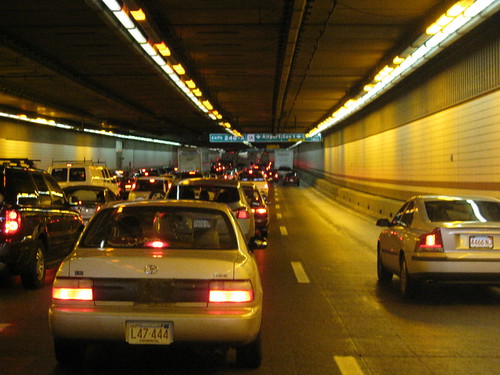 |
| The Big Dig (source) |
Fast-forward to 2006: a study was commissioned for the Massachusetts Turnpike, reporting on the economic benefits of the Turnpike and the Big Dig. The work was performed by the Economic Development Research Group from Boston, and was touted as good news for proponents of the Big Dig. From the report, the headline number for the Central Artery/Tunnel and the Ted Williams Tunnel projects is that they contribute to $168 million/year of estimated economic benefits:
These improvements are now providing approximately $168 million annually in time and cost savings for travelers. This includes $25 million of savings in vehicle operating cost plus a value of $143 million of time savings. Slightly over half of that time savings value ($73 million) is for work-related trips, and can be viewed as a reduction in the costs of doing business in Boston.They do not mention if this takes into account the congestion being generated at the new, outer bottlenecks. The report also provides several charts with traffic counts. For example, at the time of the measurements, the average volume per day on the Central Artery/Tunnel was 154,009 vehicles, and in the Ted Williams Tunnel it was 53,927 for a combined total close to 210,000 (but some of those may be double-counted).
Let's put those numbers in context. Suppose we take the overall cost of the Big Dig, at $22 billion:
In all, the project will cost an additional $7 billion in interest, bringing the total to a staggering $22 billion, according to a Globe review of hundreds of pages of state documents. It will not be paid off until 2038.The cost works out to $105,000 per daily vehicle. By comparison, Phase I of the Second Avenue Subway is projected at $19,000 per daily rider and the Green Line extension is expected to be $18,400 per daily rider. In addition, at the rate of the supposed economic benefits of the Big Dig, $168 million per year, it will take 131 years to reach a total of $22 billion in benefits. That's without factoring in maintenance over time. And don't forget, we're still paying for the original project:
The authority's annual payments on its Big Dig debt are $115 million now. Those payments will level off at $145 million annually by 2020 and continue for another 18 years.For example, the draft STIP for next year includes $150 million programmed for repayment of Grant Anticipatory Notes -- a form of debt employed by the Big Dig financing.
 |
| The surface artery |
The other economic effects of the Big Dig are much harder to quantify, although EDR Group does make an attempt to describe some of them. Unfortunately, they also focus too much on past work such as the Prudential Center, which really holds no relevance to this question. Certainly, removing the horrible "Green Monster" from downtown Boston is a good thing. But the question that seems to have never been considered is: could this have been done without constructing a tunnel? A surface artery, similar to the 6-lane highway that now exists, could have provided many of the same benefits. You could even add the Ted Williams Tunnel back, to help untangle traffic going from I-90 to the airport. For commuting purposes, a vastly improved public transportation system could have been much more cost-effective and land-efficient -- not requiring enormous parking garages to be constructed downtown.
In any case, what's done is done. The Big Dig is here to stay for the next few decades, at least until more concrete blocks start falling down again. But let's not be fooled into thinking that it was a good value. The Greenway has many problems, and although it is better than an elevated highway, that is not saying much. There is no way it was worth $22 billion to get what is basically a glorified median strip. And the touted economic benefits of the highway are paltry in comparison to the overall cost. It is hard to imagine that the Big Dig would ever have been approved if all this was known upfront.
Update: The estimated overall cost was revised upwards yesterday, again! $24 billion.
See also: The Big Dig, part 3.
And the Silver Line railstitution that they sandbagged was estimated at $11,000 per rider, using obscenely high estimates of cost (nearly $100 million per km for light rail) and a rail bias factor of effectively zero.
ReplyDeleteThanks for this, Matthew. Speaking of the Ted Williams, for $24 billion they probably could have constructed an entirely new airport (Denver's, handling almost twice the volume of Logan, was built for a way-over-budget $7 billion in 2010 dollars) -- perhaps "Boston-Providence International", Boston's answer to Dulles -- and linked it to both cities with maglev high-speed rail (another $5 billion, based on estimated costs for a Baltimore-Washington maglev), with plenty left over for the Silver Line project. Something like this has apparently been a semi-serious proposal: http://www.boston.com/bostonglobe/ideas/articles/2010/10/31/aerotropolis/?page=1.
ReplyDeleteNot saying it's necessarily a good idea, or even politically feasible, just that the money looks like it would have worked out.
As far as the boulevard alternative, presumably it would need to be paired with a hefty congestion charge, but beyond that I really have no idea.